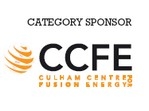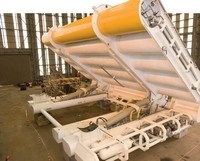
OYSTER
Aquamarine Power andQueen’s University, Belfast
With interest in renewable energy growing steadily, Aquamarine Power’s waveenergy converter, Oyster, has come along at the right time. The Edinburgh-based company worked with Trevor Whittaker, who heads a wavepower research group at Queen’s University Belfast (QUB), to design the device, which combines technologies from more conventional waveenergy devices with hydroelectric power.
The Oyster is a hinged flap that, unlike most wave-energy devices, is attached to the seabed, about 10m down, rather than floating on the surface.

When waves roll over the flap, it moves up and down, driving hydraulic pistons to send highpressure water via a pipeline to an onshore turbine. The design is simple, low-cost and robust, the company says, and as it is located near to the shore in fairly shallow water, it is accessible and easier to maintain than deepwater converters. Aquamarine envisages the device being deployed in farms generating
100MW or more. The first smallscale test device is being installed at the European Marine Energy Centre in Orkney, where tests are expected to begin this year. The results of these will be used to design the full-scale commercial Oyster II device.
Whittaker and his team at QUB have been instrumental in getting the project to this stage, according to Aquamarine.
The team carried out all the precursor R&D on the project, including tank testing at 1:20 and 1:40 scale, and is currently testing the first scale models of Oyster II. Aquamarine cosponsors PhD students in the group, as well as students from Edinburgh University, in order
to create a pool of talent for the marine-power industry.
STEALTH TECHNOLOGY ENABLES WIND ENERGY
BAE Systems, Vestas, Manchester University and Sheffield University
When wind farms are being planned, one of the most common concerns raised is over the effect that the wind turbines have on aviation and marine radar. With virtually every suitable site out of line of sight of one of these systems in production, the problem is likely to become more acute. To counter this, DBERR (now the DBIS) set up a project to reduce the radar signature of wind turbines. It also set up a consortium led by BAE Systems to tackle the £1.2m programme.
The consortium included wind-turbine maker Vestas, and Manchester and Sheffield universities. The former of these provided expertise in the different types of radar system, while the latter brought an active stealth technology, as yet uncommercialised, to
reduce the Doppler signal associated with the rotating turbine blades.
BAE provided radarabsorbent material design, mathematical modelling of defence and air-trafficcontrol radars, as well as
radio propagation and radar signature expertise.
By the end of the threeyear project, the team had developed structural radarabsorbent materials that form the load-bearing skin of the turbine blades. It had also found a way of reducing the apparent radar signature of the turbine nacelle by increasing the total radar signal but deflecting the energy towards the ground.
Talks have now begun with a turbine manufacturer and a UK energy utility into building a ‘stealthy turbine’ wind farm. This will be the subject of a three-year successor project costing £6m.
TITANIUM ALUMINIDE TURBINE BLADES
Rolls-Royce, Birmingham University and Swansea University
Weight is one of the most important parameters in aeroengine design; the lighter the engine, the less fuel it uses.
Aero-engine makers are always looking for lightweight material that can withstand the conditions in the engine, particularly the very high temperatures.
Titanium aluminide (TiAl) alloys were seen as very promising in the early 1990s, but proved to be difficult to make to high quality at a reasonable cost.
The only way that seemed to be practical was to cast oversized components and machine them back to the right proportions.
Rolls-Royce has designed a process based on centrifugal casting, where the mould is spun at high speed to force molten metal into shape. Previously, the pieces produced by this technique were porous and the pores could only be removed by high-temperature pressing, which left dents in the surface.
Casting expert Paul Withey has been working with a team led by Mark Cross at Swansea University, which has developed a physics-based modelling programme to simulate the way the metal flows into the mould, including the generation of bubbles in the flow. The Casting Research Group at Birmingham University used these results to develop the casting process. The key to reducing porosity turned out to be the gating system, which allows metal into the mould. The team plans to implement this technology for a full-scale manufacturing process.




Nanogenerator consumes CO2 to generate electricity
Whoopee, they've solved how to keep a light on but not a lot else.